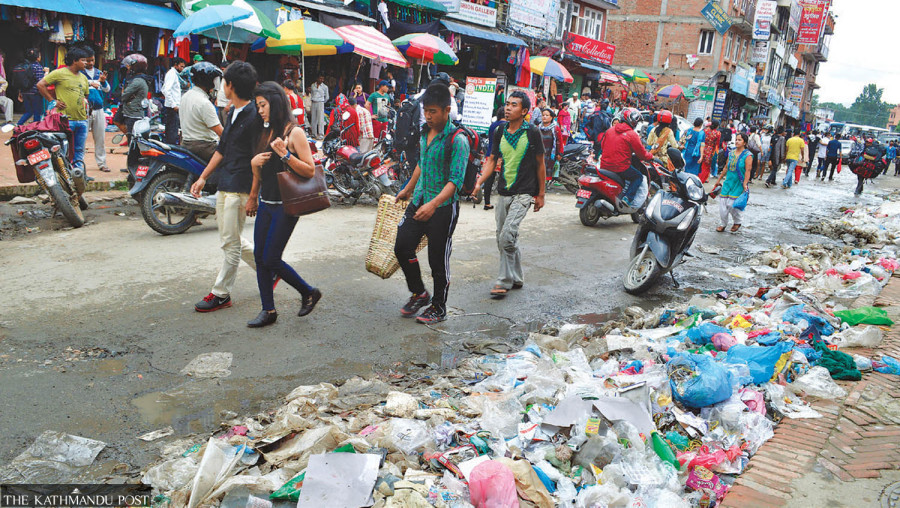Health
7 cholera cases in 5 days raise alarm
The recent uptick in cholera infections in Kathmandu Valley could just be the tip of the iceberg, health experts say.
Arjun Poudel
With three more people infected with cholera in two days, the tally of the confirmed cases of the contagious bacterial disease in Kathmandu Valley since Sunday has reached seven.
Vibrio cholera 01 Ogawa serotype has been detected in stool samples of seven individuals so far, officials at the Ministry of Health and Population confirmed.
The deadly disease has been found in diarrhoeal patients from Bagbazar, Dillibazar, Balaju, Balkhu, Sanepa and Kapan areas, raising the risk that the deadly pathogens might have already spread in several other places of the Capital. The development so far, public health experts say, is alarming. It could be just the tip of the iceberg, they say.
The situation is worrying, say experts, given that all seven infected individuals have diarrhoeal symptoms while generally only one in 10 people who get infected with cholera develop severe symptoms such as watery diarrhoea and vomiting.
“The infection might have spread to many places of the Valley, as only around 10 percent of infected people get severely ill from the infection,” said Dr Prabhat Adhikari, an infectious disease expert. “About 80 to 90 percent of infected people might not be aware of the infection and could be unwittingly spreading it to others.”
Due to poor sanitation and hygiene conditions, Nepal is highly vulnerable to water-borne diseases including diarrhoea, dysentery, typhoid, hepatitis, and cholera, with thousands of people getting infected with them every year.
According to the Health Ministry’s data from the last fiscal year, for every 1,000 children under five years of age, 349 suffered from diarrhoeal diseases.
Doctors say that the bacteria is present in the faeces of an infected person for up to 10 days.
With the confirmation of the deadly pathogens in the patients, authorities deployed a team to survey the infections. Water samples from household taps and tube wells in Bagbazar were found contaminated with E.coli and Coliform—the microbes found in human faeces.
“We have deployed a team to survey the areas where diarrhoeal patients have been infected with cholera,” Dr Chuman Lal Das, director at the Epidemiology and Disease Control Division, said, adding that the team will collect water samples to locate the source of infection.
Experts say testing water samples after an outbreak is akin to digging a well for water after a fire breaks out. They say that such a tendency in the authorities goes on to prove that there were no takeaways from the Covid-19 pandemic, which killed thousands and infected hundreds of thousands of people throughout the country.
“We have been warning of a cholera outbreak in Kathmandu Valley since May after the garbage started to pile up in the streets,” said Dr Baburam Marasini, former director at the Epidemiology and Disease Control Division. “Monsoon has just started and we already have cholera outbreaks in densely populated areas where water and sanitation conditions are very poor.”
Cholera is a highly infectious disease that causes severe diarrhoea and vomiting, which causes dehydration and can lead to death within a few hours if left untreated. The World Health Organization says cholera is a global threat to public health and an indicator of inequality and a lack of social development.
“Monsoon has just begun and we already have several cases of cholera,” Marasini said. “The disease can spread massively in the Capital this year since this is just the beginning of the monsoon season.” Cholera outbreak generally happens after August in Nepal, he added.
In October last year, a cholera outbreak in several local units of Kapilvastu killed at least four people including three minors—boys aged seven and two, and a five-year-old girl. Another deceased was a 45-year-old man.
Following the outbreak, the Health Ministry had launched a mass vaccination drive against the disease after all its attempts to curb the infection failed.
The current outbreak of cholera is blamed on contaminated water with the increase in rainfall and disruption in garbage collection in Kathmandu Valley. Several other factors including the condition of water supply pipes, water storage, and pollution in water sources affect the quality of water supplied to households, officials said.
The Kathmandu Upatyaka Khanepani Limited still uses the old pipeline laid decades ago in core city areas. Since there are leakages in the old pipelines, there is a high risk of sewage mixing with drinking water. Although the KUKL chlorinates the water before supplying it to households, it is still prone to contamination due to the leaking pipes.
Doctors warn that the chances of disease outbreaks not only of cholera but also dysentery, typhoid, hepatitis A, and E, among others, are high due to poor hygiene and contaminated water.
Adhikari, the infectious disease expert, said that the authorities' responsibility towards public health does not end with finding the cause of the cholera infection. “The source of the outbreak must be identified and then contained,” he said. “Massive awareness drives should be launched to lessen the risks of infections and for behavioural change in the public.”
The World Health Organisation says that a multifaceted approach is key to controlling cholera and reducing deaths.
Doctors say launching awareness drives against water-borne diseases and ensuring safe drinking water are the only ways to save people from dying of water-borne diseases, including cholera.
A combination of careful survey, ensuring safe drinking water, maintaining sanitation and hygiene, social mobilisation, and treatment is required to contain the spread of the infection, according to doctors.
Apart from all these things, authorities should also start preparation to vaccinate the close circle of the infected people, said Dr Janak Koirala, an infectious disease expert. “Boil water at least for five minutes before drinking,” he advised, “whether it is bottled water or tap water.”




 18.12°C Kathmandu
18.12°C Kathmandu














